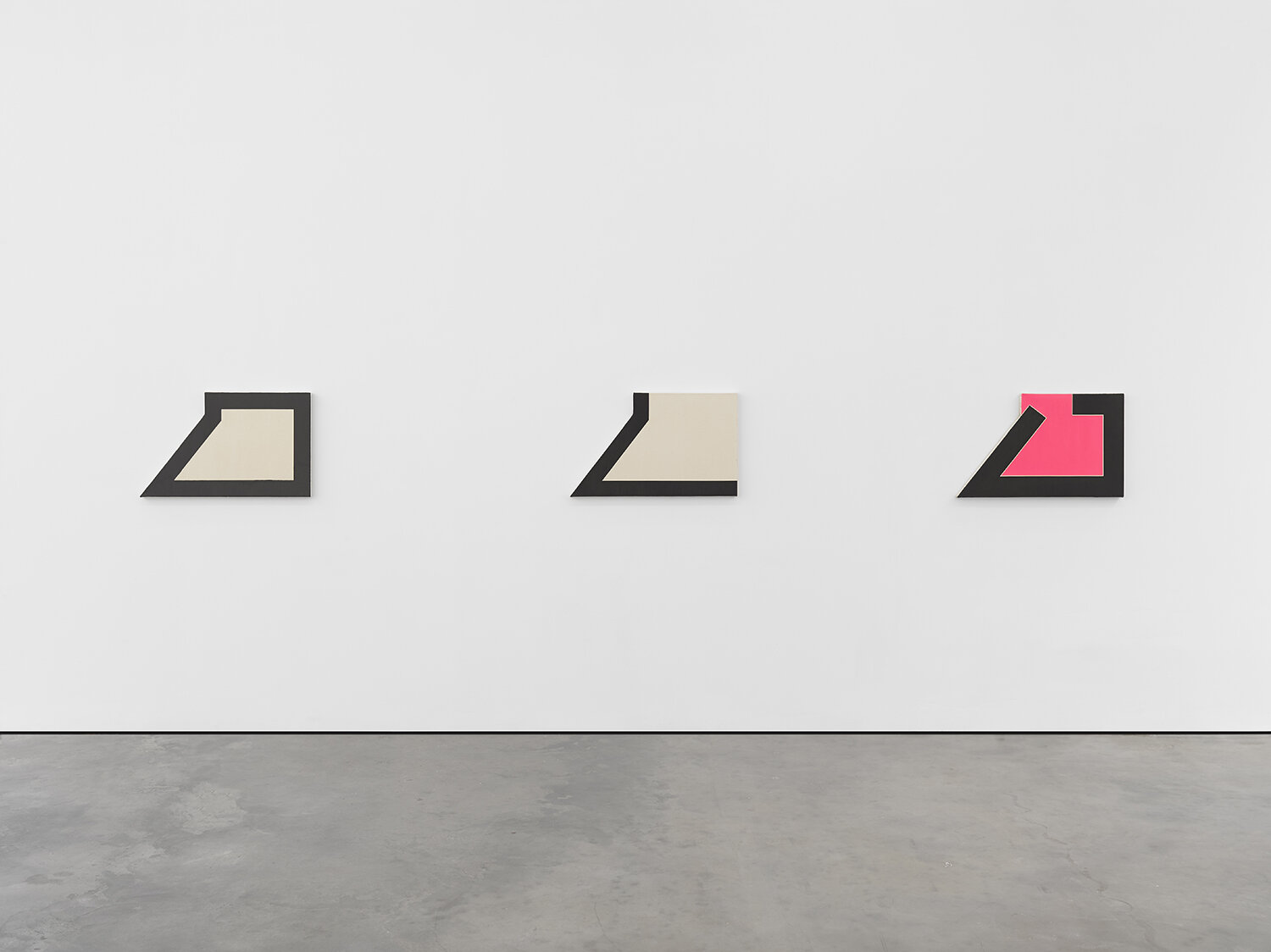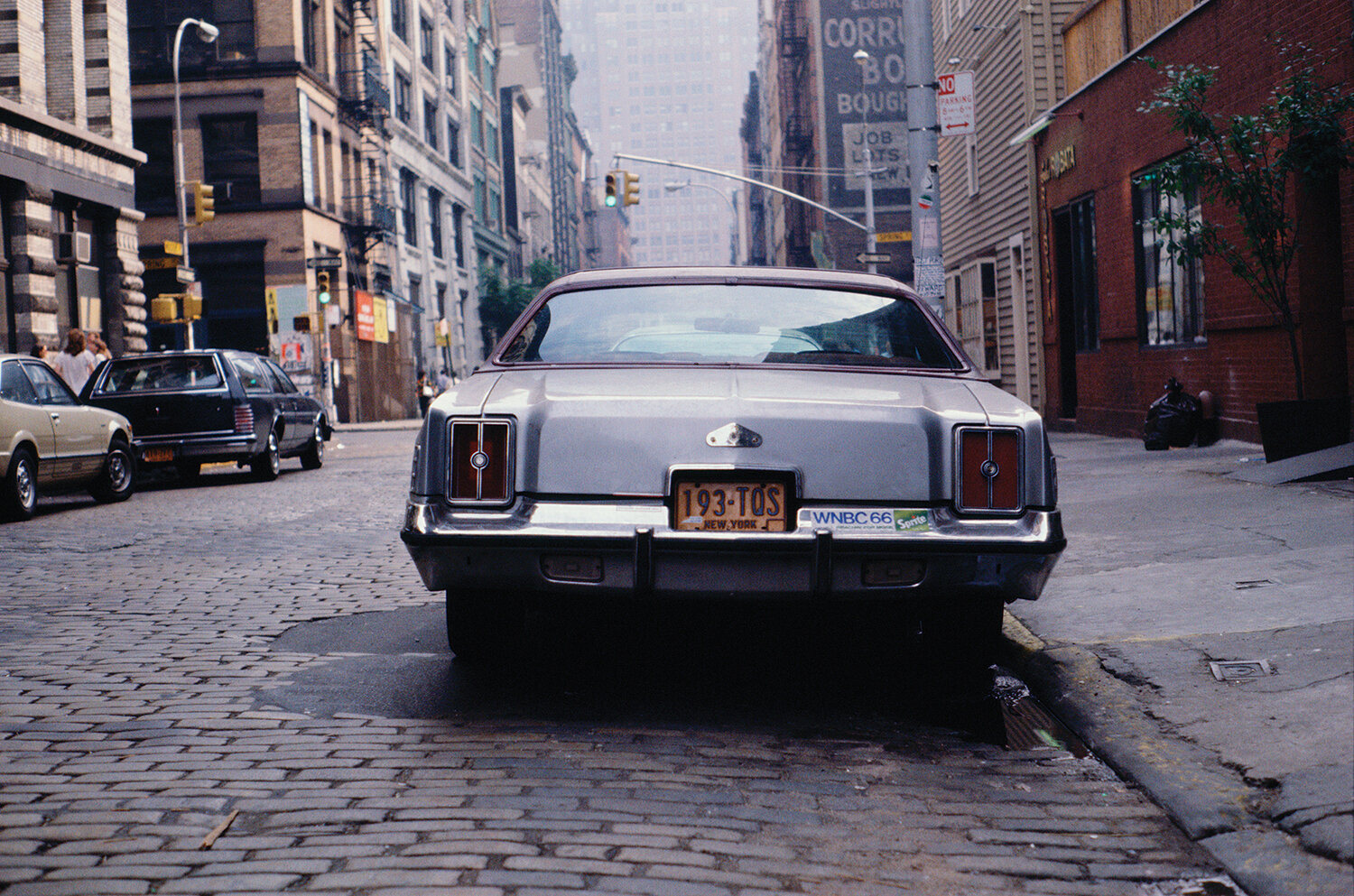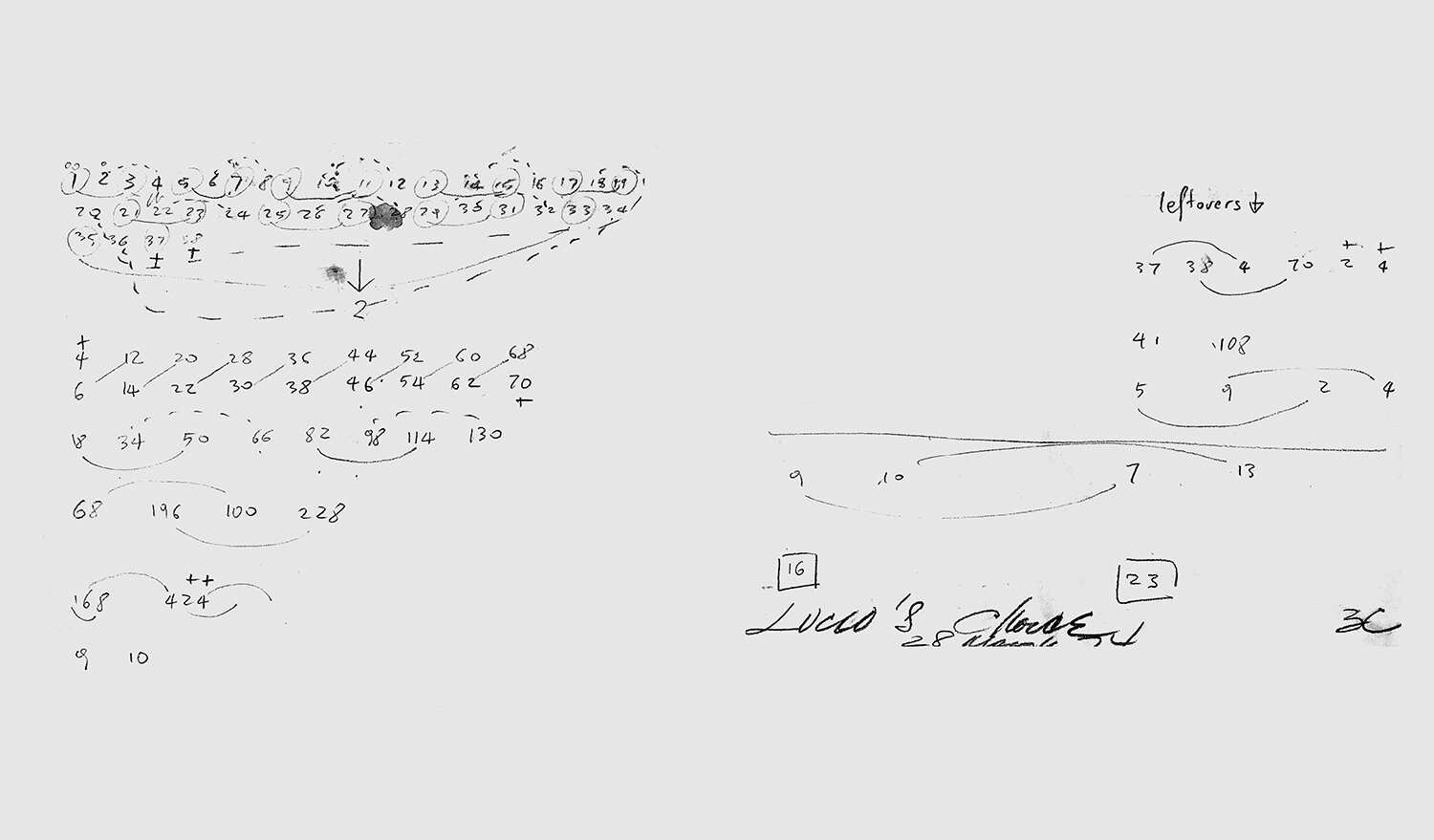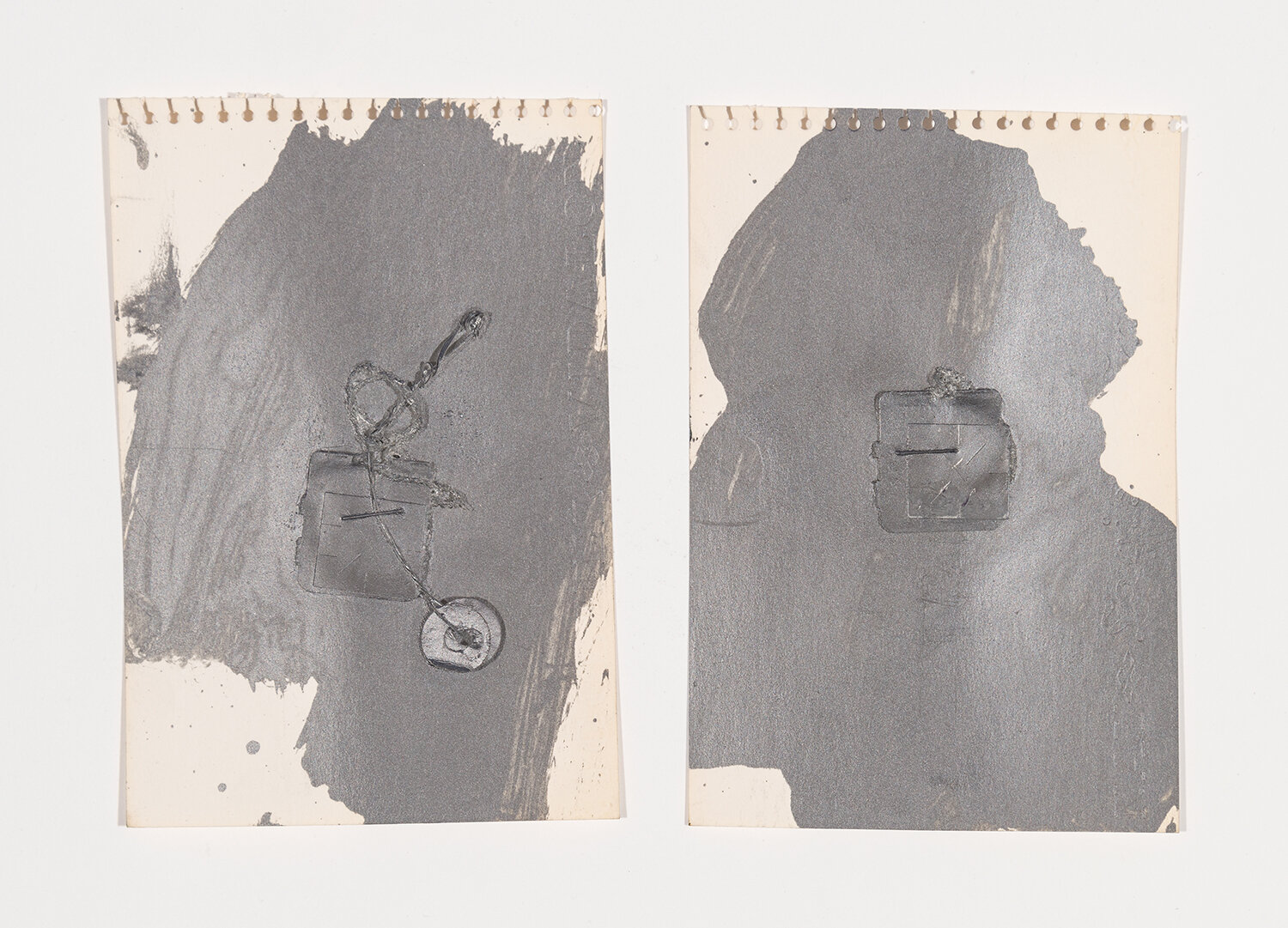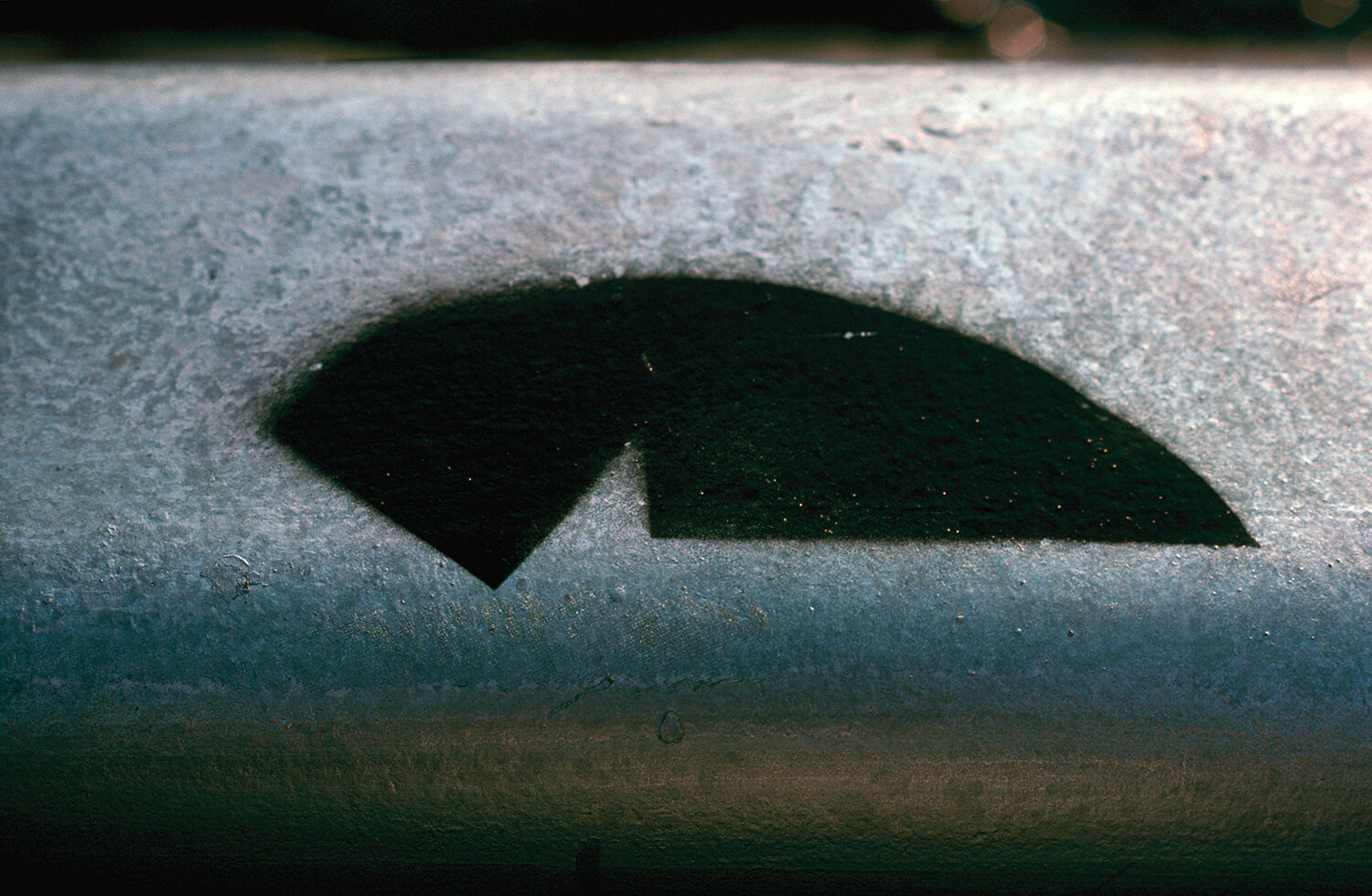Work
Stamm developed focused conceptual series of work that included paintings, works on papers and studies. The major series are titled Woosters, Dodgers, Zephyrs, Chance, Tags and X Large. His practice extended beyond the studio, to areas including street art, Designators, photography, site-specific installations and participatory based art projects. Stamm’s work are fully abstract, and it is unnecessary for the viewer to know the origins of what he or she is looking at in order to experience them the way the artist intended. Black is a consistent component of Stamm’s work, a color that he associated with rebellion, rigor and reduction. Stamm’s work is included in a number of prominent museum collections.
Ted Stamm Woosters, Lisson Gallery, New York. Exhibition view.
Ted Stamm, Woosters
In 1974, Stamm began the “Woosters” series that he continued to develop throughout his life. The work consists of a rectangle with a shorter triangle attached to the left. The triangle shape derived from a found form Stamm discovered on Wooster Street in SoHo Lower Manhattan, New York where he lived and worked from 1970–1984.
The “Wooster” paintings and works on paper went through many transformations, the geometry of the shape remained the same, however, the scale, color and material varied. The early works were heavily textures, painterly, drippy, experimental and included more loose gestures similar to the early “Dodgers” work. As the surface became less gestural, the shape became elongated and the height of the canvas decreased to include the “Lo Wooster’’ series that were installed lower to the ground. The “Wooster” works on paper and studies further emphasize the importance of how drawing is central to the way Stamm worked and conceptually developed the work. Demonstrated by the numerous studies and finished autonomous work on paper created simultaneously with the paintings.
Stamm’s Woosters paintings and works on paper are in the following select permanent collections: The Hall Art Collection in Derneburg, Germany and Reading, Vermont; The Art Gallery of Western Australia in Perth, Western Australia; The Museum of Modern Art MoMA in New York, New York and The San Jose Museum of Art in San Jose, California.
Ted Stamm, DGR-43 (Dodger) 1978, oil on canvas, 33 x 128 in, 84 X 325 cm. Ted Stamm © 2021.
Ted Stamm, Dodgers
In 1975, Stamm simultaneously developed the Dodger and the Woosters series. The latter titled after the Brooklyn Dodgers baseball team. The Dodgers curved forms and right angles derive from the shape of the baseball field diamond. The Dodger series, by far the largest group of work in Stamm’s oeuvre, remained a focus throughout his practice until his death in 1984. Starting with the Dodgers in 1975 to 1978 the works were titled with the abbreviation “DGR” for “Dodger”. Then evolved into the “C-DGR” for “Concorde Dodgers” from 1978 to 1983. The “C” in the title refers to the supersonic “Concorde” aircraft, Stamm would often travel to see it arrive and depart at John F. Kennedy International Airport, JFK in New York.
Stamm enacts an almost cartographic transposition of these horizontal topographies into the vertical orientation of painting. Of course Stamm’s works are fully abstract, and it is unnecessary for the viewer to know the origins of what he or she is looking at in order to experience them the way the artist intended. Stamm goes a step further than other artists, selecting his shapes precisely for their irreducibility to anything specific in the sense of being familiar and known to the viewer. His obsession with baseball informed and influenced the largest series of work Stamm created, titled “Dodgers” consisting of paintings, works on paper, sketches, tags, documentations of street art and mail art.
The “Dodger” paintings and works on paper went through many transformations, the development from 1975–1984 reveals how, within that system, the shape was refined and augmented over time. From the beginning of his use of black, all of Stamm’s works are more or less flat. With the more even application of black, the disappearance of any drips and the use of a non-reflective black (NRB) paint, that characteristic became more exaggerated.
The early “Dodgers” consisting of eccentric shapes were painterly, drippy and created with multiple canvases. In 1978, the “Dodger” shape morphed into a more regular shape, with arched stretchers that emphasizes frontality, flatness and the integration of the overall form with the internal drawing of the painted canvas. Stamm became increasingly engaged with the concept of speed and evolved the “Dodgers” form into a new group titled “C-DGR”, the “C” in the title refers to the supersonic “Concorde” aircraft. All of the paintings continued Stamm’s investigation into the possibilities of shape, line, pigment, canvas and architectonic structure. In this system, shape was a constant that was refined and augmented over time, while Stamm readily diversified the internal forms.
Stamm’s Dodgers paintings and works on paper are in the following select permanent collections: Guggenheim in New York, New York, The Museum of Contemporary Art MOCA in Los Angeles, California and The Art Gallery of Western Australia in Perth, Western Australia.
Ted Stamm, ZYR-4 (Zephyr) 1979, oil on canvas, 33 x 114 in, 83.8 x 289.6 cm. Collection: Foundation Louis Vuitton, Paris, France.
Ted Stamm, Zephyrs
In 1979, Stamm began the “Zephyrs” series inspired by the futuristic, stainless steel Zephyr train that set a speed record for travel between Denver and Chicago in 1934. Stamm’s later paintings “ZCTs” and “CDDs” from the early 1980s hybridized various elements from his earlier “Wooster” and “Dodger” works. Stamm’s Zephyrs paintings and works on paper are in the following select permanent collections: Fondation Louis Vuitton in Paris, France; The Brooklyn Museum in Brooklyn, New York and The Art Gallery of Western Australia in Perth, Western Australia.
Ted Stamm, Kiffman’s Roll (Chance), 1973, acrylic on canvas, 60 x 216 in, 152 x 548 cm. Ted Stamm © 2021.
Ted Stamm, Chance
In 1973, Stamm developed a conceptually based group of paintings and works on paper, collectively titled “Chance”. He invented a system, where the roll of dice or spinning of a roulette wheel determines the format, black color and layers of paint for each work. The variations of the black color were assigned a number that would match the dice or the roulette wheel outcome. The need for a large number of different black color options further aided in the development of one of the most consistent characteristics of Stamm’s mature work, his use of black. Stamm kept experimenting and constantly mixing pigments, graphite and materials to achieve the Ultimate Stamm black color.
Often, friends would roll the dice or spin the roulette wheel and the resulting painting title would include their name. For example, Kiffman’s Roll (1973) the painting comprises four panels. These large multipartite works introduced Stamm to the idea of the ability of his art to engage with the architecture around it. Stamm stated, “It was the elongated dimensions and the density with which these pieces sat on the wall that signaled my attention and concern for the paintings [sic] installation.” This was to develop into a major aspect of the work’s vocabulary in the years to follow.
The “Chance” studies and works on paper reveal that the cohesion of what Stamm exhibited was enabled by an intense diversity of experimentation of trial and error in the studio. There, not unlike an engineer, he tested various paint types, colors, game systems and compositional possibilities within the rigorously determined formats. Stamm tested the limitations of what might be thought to be abstract painting.
Historically a number of artists in various media have works based on randomness or acts of chance, for example: the writer André Breton, the composer Carlheinz Stockhausen, the artist/composer John Cage and the visual artist François Morellet. The inclusion of a theory of randomness elevates these works outside of the purely aesthetic spaces they might exist in. Embracing the process of chance, Stamm joins this group of chance based experimental methodology. Stamm differs from artists like François Morellet, who included the aspect of participatory collaboration in the actual execution and painting of the works. Stamm was solely responsible for the painting or drawing of the finished works within his “Chance” series. Morellet was concerned with craftsmanship and to purge elements of personal taste. Whereas Stamm leaves his personal mark and fingerprint can be seen on the edges of the surface.
Stamm’s experimental approach to his work inspired Edik DeAk in 1978 to write that Stamm’s work reminded her of, “people of various races who share a subway, the crowding of the elements, at the convergence points, produce the awkward and exciting coexistence”. DeAk was a critic and downtown scene maker with a mission, in the 1970–80s, to cover artists overlooked by the mainstream press through the journal Art-Rite, that she co-founded, and through her writing in the pages of Artforum. In context, her writing on Stamm’s work communicates a, “larger plan through the artist’s own conviction. Stamm’s work has clear conviction and it can be seen within the physical, actual works, the “Chance” concepts and methodology.
Stamm exhibited works from the “Chance” series in 1974, as part of a group exhibition “On View” at The Brooklyn Museum in Brooklyn, New York. In 1981, “Kiffmans Roll” was included in the Ted Stamm Paintings 1972–1980 exhibition curated by Per Haubro Jensen on view at The Clocktower, MoMA P.S.1 in New York, New York.
Ted Stamm, Untitled (Tags) 1974, graphite and ticket stub on paper, 26 x 20 in, 66 x 50.8 cm. Ted Stamm © 2021.
Ted Stamm, Tags
In the early 1970’s SoHo was still filled with active warehouses and manufacturing near Stamm’s studio. He found a large group of tags on the street these were used as the foundation for a series of “Tag” drawings created in 1972 through 1974. The tags were attached to the paper and similarly to the “Cancel” paintings, partly covered with graphite. Later, Stamm included tags as an element in collaborative projects and experimental works on paper combined with paint, spray paint, marker and stamps.
Stamm also engaged in making highly experimental works produced in collaboration with other artists and individuals during 1974–1984. The “Tag” collaborations included the participation of visitors to his studio who were asked to make a mark of their choosing onto a found garment tag that was glued down onto a page in a sketchbook. Stamm would respond to this mark in a second sketchbook of the same design. Both pages were then stamped with the date and other collateral information to create a record of their exchange. Stamm’s “Tag” series were included both in group exhibitions at Franklin Furnace, New York in 1980, 1977 and in the Art Rite #4 issue magazine in 1973.
Ted Stamm, 31 Revisited Designators, 1979. Soho, New York. Ted Stamm Archive © 2021.
Ted Stamm, Designators, Street Art
In 1976, Stamm started a series of street art work that he labeled “Designators”. The primary methods used in the “Designator” series were stencils sprayed or brushed with paint or stamped adhesive labels. The stencils took the form of the “Dodger”, “T” or “TT” shape and the adhesive labels originated from the “Wooster” shape. Stamm continued the series until 1980 and documented these works extensively over time. The photographic documentation included different one point street perspectives at various locations in New York City. The “Designators” series was created simultaneously with his paintings and works on paper, which were included in galleries, museum exhibitions and included in press articles.
Stamm’s peers included many artists creating work in relation to the streets of New York City. Richard Artschwager began his “Blps” street art series in 1968 in various street locations. In 1973, Forrest Myer installed “The Wall”, a minimal large scale street mural a few blocks from Stamm’s studio, questioning the concept of public space and scale. In 1976, the same year that Stamm started his Designator series, Richard Hambleton’s police “chalk” outline, part of a “crime scenes” series, started appearing in Lower Manhattan. Also, in 1976, Richard Artschwager installed a number of his “Blps” at the recently opened PS1 in Long Island City. Two years later, in 1978, Jean-Michel Basquiat’s “SAMO” tags started appearing around New York City and Sol Lewitt explored “Photogrid” photography documentations of Doors bringing the street inside the art gallery. In 1980, Keith Haring started his graffiti art in subways and was included in a major “Post-Graffiti” exhibition in 1983 at the Sidney Janis Gallery. These are just a few examples of the work that could be found in the streets and subways predominantly in Lower Manhattan at the time.
Stamm’s “Dodger” Designators were created with a custom metal stencil “Dodger” shape sprayed with paint in locations in and around New York City that had significance to him: the building he lived in, the steps of his local post office, the building in which a close friend lived. On the first visit he painted the shape; on a second visit, if the image had been altered, he painted a silver “Dodger” over it; the third time, he stenciled a black “T” on the silver shape; and on the final visit, he made a silver “T”. In this project the “Dodger” not only designated places of biographic importance but also marked the passage of time emblematic of Stamm’s art, it registered his presence in the world. Stamm stenciling creates a uniform shape throughout its use; it is easier for an artist to replicate compared to conventional tagging methods and facilitates more precise paint coverage and improving visibility. The “Designators” containing “Dodgers” and “T” shapes developed from 1976 through 1980 located in downtown New York and few select locations outside of Manhattan. Stamm proposed the “Designator” works to be exhibited in the “rooms” section at PS1 in Long Island City in 1977.
The “Designator” series further developed with the “Woosters” adhesive labels during June and July of 1980 each documented and photographed with each visit. These works were ready to be seen outside the walls of a gallery and monitored over time. The labels both in white and orange were applied to automobile license plates and bumpers throughout Soho, New York. The “June 17, 1980” series consists of white adhesive labels stamped with two dates “June 17 1980” and “June 29 1980” created in advance for quick discreet application on a variety of automobile license plates. Each automobile is documented through two photographs, one close up, one at distance to show context and scale. The next Wooster Designator series, titled “July 17, 1980” consists of orange labels that were placed on automobile bumpers. All the automobiles are documented through photographs at a distance to show context and scale.
Stamm documented each “Designator” series by photographing and dating the development over time. The “Designator” photographs and documentation was in turn catalogued alongside the paintings, works on paper and exhibition proposals. Stamm’s exhibition concepts were informed by street art’s creation process which puts into focus to convey a specific message and with a subculture environment.
Ted Stamm, Bicycle Ride, 1971, site-specific performance, Brooklyn Bridge, New York. Ted Stamm Archive © 2021.
Ted Stamm, Site-Specific Projects
Ted Stamm, ZCT-001 X (Zephyr Concorde) 1982, graphite on paper, diptych, 30 x 85 in, 76 x 215 cm. Ted Stamm © 2021.
Ted Stamm, X Large works on paper
In 1980, Stamm began developing his first extra large works on paper, adding the letter “X” to the title of existing or new series, for example: IX (Install Large), IXC (Install Large Concorde), LWX (Lo Wooster Large), RRX (Rectangle Rectangle Large), TX (Triangle Large), WDGX (Wide Dodger Large) and ZCT (Zephyr Concorde Tri). The “X” in the title indicates that the work is larger than a conventional paper size. The work included in the “X” series is created with either one continuous large sheet or two sheets of paper attached as a diptych. The drawings are built up with thin layers of graphite or charcoal to produce a rich surface revealing the artists hand and work methods. The importance of drawing is central to how Stamm worked and conceptually developed his work, attested by the studies and finished autonomous drawings executed simultaneously with the paintings. The finished drawings explore, within a format closer to the paintings, many compositional options and various drawing elements as the work is created, over a time consuming process that could take several weeks to complete.
Ted Stamm, IXS, 1983, acrylic on canvas, 56 x 237 in, 76.2 x 381 cm. Collection: Art Gallery of Western Australia, Perth, Western Australia.
Ted Stamm, Select Museum Collections
Stamm’s work is in a number of public collections: The Aldrich Contemporary Art Museum in Ridgefield, Connecticut; Brooklyn Museum in Brooklyn, New York; Carnegie Museum in Pittsburgh, Pennsylvania; Fondation Louis Vuitton in Paris, France; Guggenheim Museum in New York, New York; Hall Art Collection in Derneburg, Germany and Reading, Vermont; Museum of, Contemporary Art MoCA in Los Angeles, California; Museum of Modern Art MoMA in New York, New York; San Jose Museum of Art in San Jose, California and Western Australia Art Gallery in Perth, Australia.

